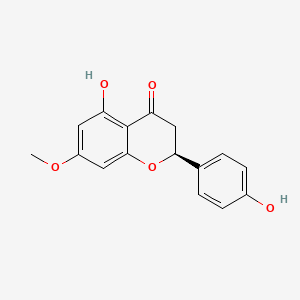| MeSH term | MeSH ID | Detail |
|---|---|---|
| Acne Vulgaris | D000152 | 35 associated lipids |
Sakuranetin
Sakuranetin is a lipid of Polyketides (PK) class. Sakuranetin is associated with abnormalities such as and Neurodegenerative Disorders. The involved functions are known as inhibitors, Drug Interactions, aldehyde reductase activity, Antiinflammatory Effect and antagonists. Sakuranetin often locates in Vacuole and Cell surface. The associated genes with Sakuranetin are PTPN1 gene.
Cross Reference
Introduction
To understand associated biological information of Sakuranetin, we collected biological information of abnormalities, associated pathways, cellular/molecular locations, biological functions, related genes/proteins, lipids and common seen animal/experimental models with organized paragraphs from literatures.
What diseases are associated with Sakuranetin?
Sakuranetin is suspected in Neurodegenerative Disorders and other diseases in descending order of the highest number of associated sentences.
Related references are mostly published in these journals:
| Disease | Cross reference | Weighted score | Related literature |
|---|
Possible diseases from mapped MeSH terms on references
We collected disease MeSH terms mapped to the references associated with Sakuranetin
PubChem Associated disorders and diseases
What pathways are associated with Sakuranetin
There are no associated biomedical information in the current reference collection.
PubChem Biomolecular Interactions and Pathways
Link to PubChem Biomolecular Interactions and PathwaysWhat cellular locations are associated with Sakuranetin?
Visualization in cellular structure
Associated locations are in red color. Not associated locations are in black.
Related references are published most in these journals:
| Location | Cross reference | Weighted score | Related literatures |
|---|
What functions are associated with Sakuranetin?
Related references are published most in these journals:
| Function | Cross reference | Weighted score | Related literatures |
|---|
What lipids are associated with Sakuranetin?
There are no associated biomedical information in the current reference collection.
What genes are associated with Sakuranetin?
Related references are published most in these journals:
| Gene | Cross reference | Weighted score | Related literatures |
|---|
What common seen animal models are associated with Sakuranetin?
There are no associated biomedical information in the current reference collection.
NCBI Entrez Crosslinks
All references with Sakuranetin
Download all related citations| Authors | Title | Published | Journal | PubMed Link |
|---|---|---|---|---|
| Zhou HF et al. | Biflavonoids from Caper (Capparis spinosa L.) fruits and their effects in inhibiting NF-kappa B activation. | 2011 | J. Agric. Food Chem. | pmid:21381749 |
| Eisenman SW et al. | Qualitative variation of anti-diabetic compounds in different tarragon (Artemisia dracunculus L.) cytotypes. | 2011 | Fitoterapia | pmid:21798321 |
| Fletcher JN et al. | In vitro evaluation of flavonoids from Eriodictyon californicum for antagonist activity against the bitterness receptor hTAS2R31. | 2011 | J. Agric. Food Chem. | pmid:22059530 |
| Molnár J et al. | Reversal of multidrug resitance by natural substances from plants. | 2010 | Curr Top Med Chem | pmid:20645919 |
| Balijepalli MK et al. | Antiproliferative activity and induction of apoptosis in estrogen receptor-positive and negative human breast carcinoma cell lines by Gmelina asiatica roots. | 2010 | Pharmacognosy Res | pmid:21808551 |
| Ellwood SR et al. | A first genome assembly of the barley fungal pathogen Pyrenophora teres f. teres. | 2010 | Genome Biol. | pmid:21067574 |
| Kishi-Kaboshi M et al. | A rice fungal MAMP-responsive MAPK cascade regulates metabolic flow to antimicrobial metabolite synthesis. | 2010 | Plant J. | pmid:20525005 |
| Tohno H et al. | Evaluation of estrogen receptor Beta binding of pruni cortex and its constituents. | 2010 | Yakugaku Zasshi | pmid:20606380 |
| Morris CE et al. | Expanding the paradigms of plant pathogen life history and evolution of parasitic fitness beyond agricultural boundaries. | 2009 | PLoS Pathog. | pmid:20041212 |
| González-Lamothe R et al. | Plant antimicrobial agents and their effects on plant and human pathogens. | 2009 | Int J Mol Sci | pmid:20111686 |
